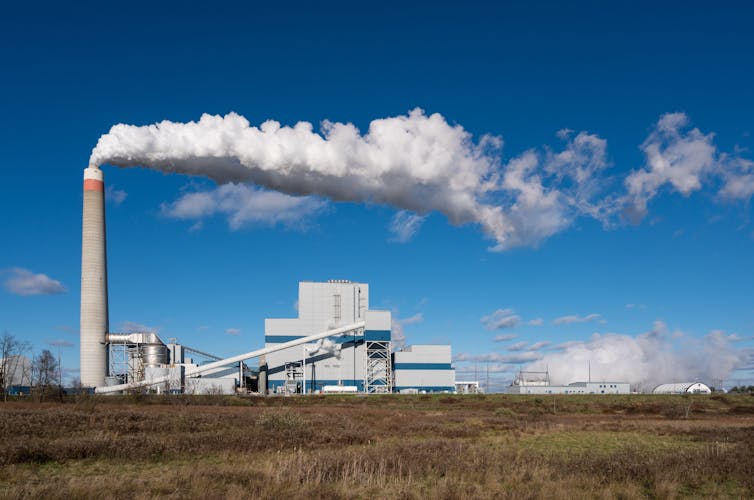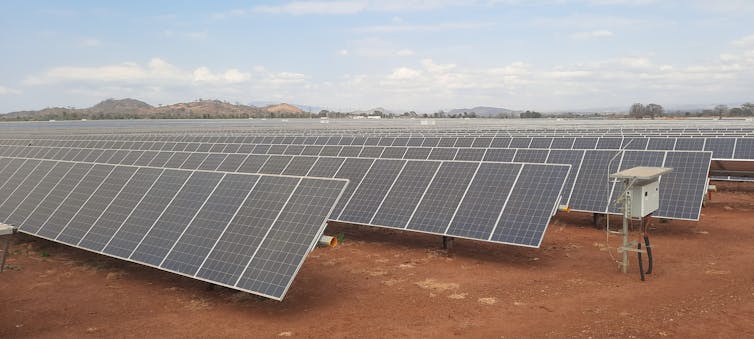How much CO₂ can humanity emit before we push global temperatures 1.5°C above the pre-industrial average? That was the limit agreed in 2015 which scientists say offers us a reasonable chance of averting climate breakdown. The answer, according to a new assessment of the remaining carbon budget, is 380 billion tonnes, or less than a decade of emissions at their present rate.
COP27, the ongoing UN climate change summit in Sharm el-Sheikh, Egypt, is a series of negotiations over how to implement previous global agreements that aimed to halt warming at 1.5°C. A case study from the continent where negotiators are currently gathered reveals what is necessary to achieve this.

Don’t have time to read about climate change as much as you’d like?
Get a weekly roundup in your inbox instead. Every Wednesday, The Conversation’s environment editor writes Imagine, a short email that goes a little deeper into just one climate issue. Join the 10,000+ readers who’ve subscribed so far.
“Based on preliminary data, we project that CO₂ emissions from coal, natural gas, oil and cement use (fossil emissions) will increase by 1% in 2022 from 2021 levels, reaching 36.6 billion tonnes,” say a team of scientists led by Pep Canadell, director of the Global Carbon Project at Australian national science agency CSIRO. “This means 2022 fossil emissions will be at an all-time high, and slightly above the pre-pandemic levels of 36.3 billion tonnes in 2019.”
A 1% growth in fossil emissions equates to around 300 million extra tonnes of CO₂. That’s like adding 70 million US cars to the world’s roads in 2022 alone, the researchers say. There is, however, a sliver of good news.
While this year’s increase in emissions is larger than the 0.5% average annual growth from 2012 to 2021, it’s smaller than the 2.9% by which emissions grew on average per year during the 2000s. “So, in relative terms, the global growth in fossil CO₂ emissions is at least slowing down,” they say.

What’s behind this year’s 1% bump in fossil emissions? Oil consumption is up, which the team attribute to airlines recovering from slow ticket sales during the pandemic. But the other issue is Russia’s invasion of Ukraine, which the researchers blame for restricting pipeline gas supplies.
Robert Brecha, professor of sustainability at the University of Dayton in the US, has gone into detail about how the war and the resulting energy crisis is affecting countries’ climate plans.
“Europe, worried about keeping the heat on through winter, is outbidding poor countries for natural gas, even paying premiums to reroute tanker ships after Russia cut off most of its usual natural gas supply,” he says. “Some countries are restarting coal-fired power plants. Others are looking for ways to expand fossil fuel production, including new projects in Africa.”
On the other hand, the war is also creating momentum to speed up the rollout of renewables. But while the way forward is relatively clear for Europe, the situation is more complex for developing countries where access to technology and finance is more restricted, says Brecha.
“Without a strong alternative within local contexts for sustainable energy resources, and with wealthy countries scrambling for fossil fuels, developing countries will exploit fossil resources – just as the wealthiest countries have done for over a century.”
‘A renewed form of colonialism’
The point that developing countries have historically contributed very little to the climate crisis makes the question of how we spend the remaining carbon budget a matter of justice, according to Chukwumerije Okereke, a professor of environment and development at Reading University, and Youba Sokona, an IPCC vice-chair and honorary professor at UCL.
Africa’s gas reserves were estimated at more than 17.56 trillion cubic meters (620 trillion cubic feet) in 2021. Opponents of gas extraction, often from developed countries, say that exploiting these reserves would blow the 1.5°C target.
Read more: Africa has vast gas reserves – here’s how to stop them adding to climate change
But gas advocates argue African nations have a right to use their share of the remaining carbon budget to develop their economies. The entire continent of Africa has contributed 4% of the CO₂ added to the atmosphere since the industrial revolution. The US alone is responsible for 25%.
“On this basis, it is argued that developed countries are enacting a renewed form of colonialism – what some might call climate colonialism,” Okereke and Sokona say. “This is because countries that developed using fossil fuels and continue to appropriate a disproportionate amount of the remaining carbon space in the atmosphere are seeking to stop Africans from using their abundant reserves of gas to address energy poverty challenges and fast track their development.”
The way out of this trap is to help Africa develop its huge renewable resources, they say. “What Africa urgently needs is a credible plan for oil-dependent economies to avoid the need to transition to gas in the long run. That must include technical and financial support to scale up renewables in all countries, so they can build self-reliant, prosperous economies.”

Holding Africans back are the broken promises of rich countries and financial institutions like the World Bank. “The US thinktank Climate Policy Initiative has suggested that Africa needs an inflow of about US$277 billion annually to implement the plans contained in each country’s emissions reduction pledge. But the continent currently only receives something in the region of about US$30 billion a year … COP27 must unlock trillions of dollars in large-scale renewable energy investments and generate new economic opportunities for Africa – or it will have failed.”
So how are things looking as the conference enters its final days? Hopes of a breakthrough deal like that made in Glasgow last year have been downplayed. But Rachel Kyte of Tufts University, an adviser to the UK presidency of the UN climate talks and former World Bank special envoy for climate change, at least sees signs of progress.
Read more: 4 signs of progress at the UN climate change summit
“How international financial institutions like the International Monetary Fund and World Bank are working is getting much-needed attention,” she says. “More public-private partnerships are being developed to speed decarbonization and power the clean energy transition …
"Negotiators seem reluctant to mention this widespread reform movement in the formal text being negotiated at COP27, but walking through the halls here, they cannot ignore it. It’s been too slow in coming, but change in the financial system is on the way.”
Whether this will be enough to help the world avoid blowing its carbon budget or achieve a just transition remains to be seen.
This article was originally published on The Conversation. Read the original article.







